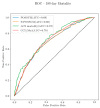Predicting 30-Day and 180-Day Mortality in Elderly Proximal Hip Fracture Patients: Evaluation of 4 Risk Prediction Scores at a Level I Trauma Center
- PMID: 33799724
- PMCID: PMC8002141
- DOI: 10.3390/diagnostics11030497
Predicting 30-Day and 180-Day Mortality in Elderly Proximal Hip Fracture Patients: Evaluation of 4 Risk Prediction Scores at a Level I Trauma Center
Abstract
This study evaluated the use of risk prediction models in estimating short- and mid-term mortality following proximal hip fracture in an elderly Austrian population. Data from 1101 patients who sustained a proximal hip fracture were retrospectively analyzed and applied to four models of interest: Physiological and Operative Severity Score for the enUmeration of Mortality and Morbidity (POSSUM), Charlson Comorbidity Index, Portsmouth-POSSUM and the American College of Surgeons National Surgical Quality Improvement Program (ACS-NSQIP®) Risk Score. The performance of these models according to the risk prediction of short- and mid-term mortality was assessed with a receiver operating characteristic curve (ROC). The median age of participants was 83 years, and 69% were women. Six point one percent of patients were deceased by 30 days and 15.2% by 180 days postoperatively. There was no significant difference between the models; the ACS-NSQIP had the largest area under the receiver operating characteristic curve for within 30-day and 180-day mortality. Age, male gender, and hemoglobin (Hb) levels at admission <12.0 g/dL were identified as significant risk factors associated with a shorter time to death at 30 and 180 days postoperative (p < 0.001). Among the four scores, the ACS-NSQIP score could be best-suited clinically and showed the highest discriminative performance, although it was not specifically designed for the hip fracture population.
Keywords: ACS-NSQIP®; Charlson Comorbidity Index; POSSUM; Portsmouth-POSSUM; elderly; hip fracture; mortality; outcome; risk prediction; scoring systems; surgery.
Conflict of interest statement
There was no conflicts of interest by any of the authors, including financial and personal relationships with other people or organizations that inappropriately influenced this study. There was no financial support for this project. There were no competing interests.
Figures



References
-
- Arce K., Moore E.J., Lohse C.M., Reiland M.D., Yetzer J.G., Ettinger K.S. The American college of surgeons national surgical quality improvement program surgical risk calculator does not accurately predict risk of 30-Day complications among patients undergoing microvascular head and neck reconstruction. J. Oral Maxillofac. Surg. 2016;74:1850–1858. doi: 10.1016/j.joms.2016.02.024. - DOI - PubMed
-
- Zhu Y., Chen W., Xin X., Yin Y., Hu J., Lv H., Li W., Deng X., Zhu C., Zhu J., et al. Epidemiologic characteristics of traumatic fractures in elderly patients during the outbreak of coronavirus disease 2019 in China. Int. Orthop. 2020;44:1565–1570. doi: 10.1007/s00264-020-04575-0. - DOI - PMC - PubMed
LinkOut - more resources
Full Text Sources
Other Literature Sources

